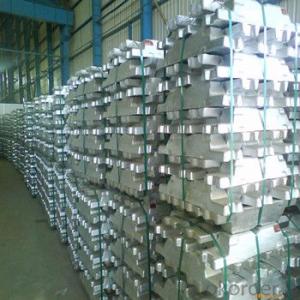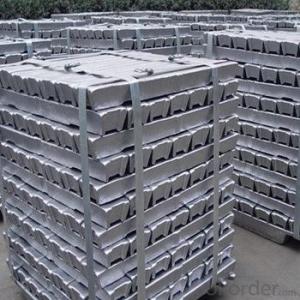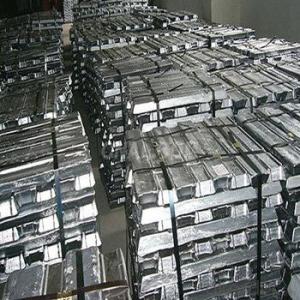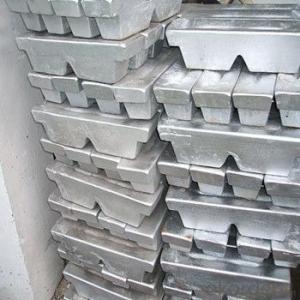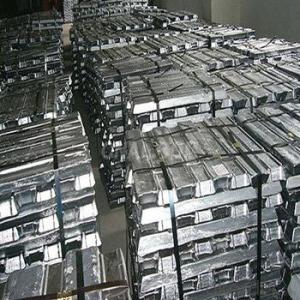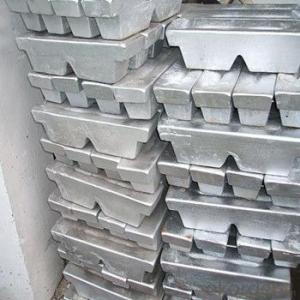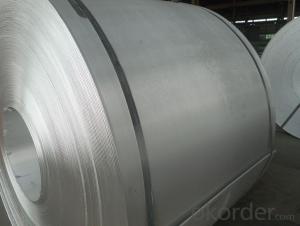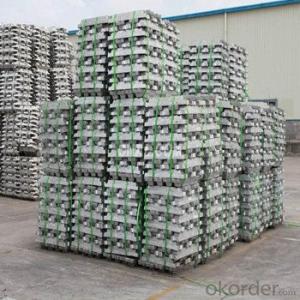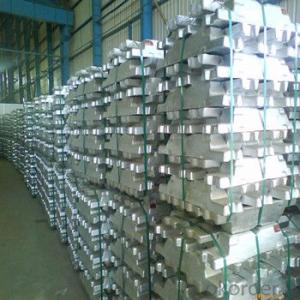Aluminium Ingot from Factory and Best Seller
- Loading Port:
- China main port
- Payment Terms:
- TT OR LC
- Min Order Qty:
- 1000 m.t.
- Supply Capability:
- 10000 m.t./month
OKorder Service Pledge
OKorder Financial Service
You Might Also Like
Pure Aluminum Ingot Used for Industry
1.Structure of Aluminum Ingot Description
Aluminum Ingot is with the AL as the main chemical composition. Aluminum Ingot is used for industry,such as automobile,pinning and weaving,electron broadly and so on. Aluminum Ingot has the following advantages: easy control and operation, fast melting.
2.Main Features of the Aluminum Ingot
•High Purity
•Easy control and operation
•High strength
•Fast melting
•Competitive price
•Best Service
3. Aluminum Ingot Images

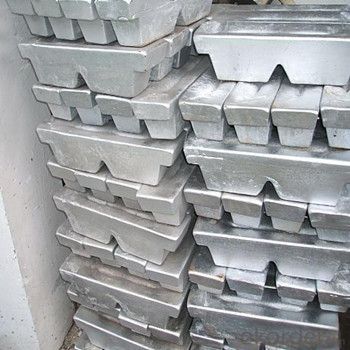
4. Aluminum Ingot Specification
Grade | Chemical Composition % | |||||||||
Al≥ | impurities ≤ | |||||||||
Si | Fe | Cu | Ga | Mg | Zn | Mn | others | Sum | ||
Al99.9 | 99.90 | 0.50 | 0.07 | 0.005 | 0.02 | 0.01 | 0.025 | - | 0.010 | 0.10 |
Al99.85 | 99.85 | 0.80 | 0.12 | 0.005 | 0.03 | 0.02 | 0.030 | - | 0.015 | 0.15 |
Al99.7 | 99.70 | 0.10 | 0.20 | 0.010 | 0.03 | 0.02 | 0.030 | - | 0.030 | 0.30 |
Al99.6 | 99.60 | 0.16 | 0.25 | 0.010 | 0.03 | 0.03 | 0.030 | - | 0.030 | 0.40 |
Al99.5 | 99.50 | 0.22 | 0.30 | 0.020 | 0.03 | 0.05 | 0.050 | - | 0.030 | 0.50 |
Al99.00 | 99.00 | 0.42 | 0.50 | 0.020 | 0.03 | 0.05 | 0.050 | - | 0.050 | 1.00 |
5.FAQ of Aluminum Ingot
We have organized several common questions for our clients,may help you sincerely:
①How about your company?
A world class manufacturer & supplier of castings forging in carbon steel and alloy steel,is one of the large-scale professional investment casting production bases in China,consisting of both casting foundry forging and machining factory. Annually more than 8000 tons Precision casting and forging parts are exported to markets in Europe,America and Japan. OEM casting and forging service available according to customer’s requirements.
②How to guarantee the quality of the products?
We have established the international advanced quality management system,every link from raw material to final product we have strict quality test;We resolutely put an end to unqualified products flowing into the market. At the same time, we will provide necessary follow-up service assurance.
③How long can we receive the product after purchase?
In the purchase of product within three working days, We will arrange the factory delivery as soon as possible. The pecific time of receiving is related to the state and position of customers.Commonly 7 to 10 working days can be served.
- Q:Cost of material consumption of aluminium ingot
- Let's first analyze the material cost of the aluminum ingot:There are three kinds of materials used in the smelting of aluminium smelting plants: 1, alumina; 2, the cost of electricity; 3, the anode paste (anode carbon block).
- Q:How are aluminum ingots used in the production of sporting goods?
- Aluminum ingots are widely used in the production of sporting goods due to their unique properties and advantages. Firstly, aluminum ingots are lightweight yet durable, making them an ideal material for manufacturing sports equipment such as baseball bats, tennis rackets, and golf clubs. The lightweight nature of aluminum allows for increased swing speed and maneuverability, enhancing the performance of athletes in these sports. Furthermore, aluminum ingots are corrosion resistant, ensuring that sporting goods made from aluminum can withstand exposure to moisture and other harsh environments. This property is particularly beneficial for sporting goods used outdoors, such as bicycles, camping equipment, and fishing rods. The corrosion resistance of aluminum ingots reduces the need for frequent maintenance and replacement, making them more cost-effective in the long run. Additionally, aluminum ingots can be easily molded and shaped into various designs, enabling manufacturers to create innovative and ergonomic sporting goods. For example, aluminum ingots are commonly used in the production of bicycle frames and components, allowing for customized designs that enhance stability, aerodynamics, and overall performance. Moreover, aluminum ingots possess excellent heat conductivity, making them suitable for the production of sports equipment that requires efficient heat dissipation. This includes skis and snowboards, where aluminum cores are used to regulate temperature and provide optimal flexibility and control on the slopes. In summary, aluminum ingots play a vital role in the production of sporting goods by offering lightweight, durable, corrosion-resistant, and easily moldable properties. These characteristics enable manufacturers to create high-performance, long-lasting, and innovative sporting equipment across a wide range of sports and outdoor activities.
- Q:How are aluminum ingots used in the production of electronic devices?
- Aluminum ingots are used in the production of electronic devices in several ways. Firstly, aluminum is a lightweight and durable metal, making it an ideal choice for manufacturing electronic device casings or housings. These ingots are melted and cast into specific shapes to form the outer shells of devices such as smartphones, laptops, tablets, and even gaming consoles. Additionally, aluminum is an excellent conductor of electricity and heat. It is often used as a heat sink material in electronic devices to dissipate excess heat generated during operation. The ingots are processed into heat sinks, which are then integrated into various components like processors, graphics cards, and power modules. The high thermal conductivity of aluminum helps in maintaining optimal operating temperatures and prevents overheating, ensuring the longevity and performance of electronic devices. Moreover, aluminum ingots are also utilized in the production of printed circuit boards (PCBs). PCBs are the backbone of electronic devices, providing a platform for assembling and connecting various electronic components. Aluminum is used as a base material for manufacturing PCBs, providing good mechanical strength and electrical insulation. The ingots are processed into thin sheets that serve as the base substrate for mounting electronic components, creating a solid foundation for the device's functionality. In summary, aluminum ingots play a crucial role in the production of electronic devices. They are used to create lightweight and durable casings, heat sinks for thermal management, and base materials for PCBs. With its excellent electrical conductivity, heat dissipation capabilities, and mechanical strength, aluminum contributes to the overall performance, reliability, and efficiency of electronic devices.
- Q:How are aluminum ingots shaped into different forms?
- The process of aluminum extrusion involves shaping aluminum ingots into various forms. First, the ingot is heated until it becomes molten. Then, the molten aluminum is forced through a specially designed die, which determines the final product's shape and size. The die, acting as a mold, is a hollow profile with the desired shape. Once the molten aluminum passes through the die, it undergoes a cooling process to solidify it into the desired shape. Cooling methods such as air cooling or water quenching can be used, depending on the product's specific requirements. After the aluminum has cooled and solidified, it is cut to the desired length. This can be done during or after the extrusion process, depending on the shape's complexity or the product's requirements. Aluminum extrusion offers a wide range of possibilities for shape production, including solid profiles, hollow sections, tubes, and intricate designs. This highly versatile and efficient process is a popular choice for shaping aluminum into different forms. Moreover, aluminum's lightweight and corrosion-resistant properties make it an ideal material for various applications, ranging from the construction and automotive industries to consumer goods and electronics.
- Q:What are the different surface treatment options for aluminum ingots?
- There are several surface treatment options available for aluminum ingots, depending on the desired outcome and application. Some of the commonly used surface treatment options for aluminum ingots include anodizing, powder coating, polishing, and painting. Anodizing is a popular surface treatment method for aluminum ingots. It involves creating a protective oxide layer on the surface of the aluminum through an electrochemical process. Anodizing provides various benefits such as increased corrosion resistance, improved durability, and enhanced aesthetic appearance. It also allows for coloring options by dyeing the oxide layer. Powder coating is another surface treatment option for aluminum ingots. It involves applying a dry powder coating to the surface of the aluminum and then curing it in an oven. The powder adheres to the surface electrostatically and creates a durable and protective layer. Powder coating offers excellent resistance to impacts, chemicals, and weather conditions. It is available in a wide range of colors and finishes. Polishing is a surface treatment method that involves smoothing and shining the surface of aluminum ingots. It is achieved by using abrasive materials and techniques to remove any imperfections, scratches, or dullness. Polishing enhances the aesthetic appearance of aluminum, giving it a mirror-like or satin finish. Painting is a surface treatment option that involves applying a liquid paint coating to the surface of aluminum ingots. It can provide both protection and decoration. Painting allows for a wide range of colors and finishes, providing flexibility in design and customization. It is commonly used for architectural applications, outdoor furniture, and automotive parts. In addition to these surface treatment options, aluminum ingots can also undergo other treatments like brushing, sandblasting, and etching. These methods can offer unique finishes and textures to the aluminum surface, depending on the specific requirements of the application. Overall, the choice of surface treatment for aluminum ingots depends on factors such as the desired appearance, functionality, and the environment in which the aluminum will be used. Each treatment option has its own advantages and considerations, so it is essential to carefully evaluate the requirements before selecting the most appropriate surface treatment method.
- Q:How are aluminum ingots used in the production of window frames?
- The production of window frames heavily relies on aluminum ingots, which play a crucial role. To begin with, these ingots are melted and shaped according to the specific requirements of the frames. The melting process involves heating the ingots in a furnace until they reach their melting point of approximately 660 degrees Celsius. Once the aluminum is molten, it is poured into molds designed to achieve the desired shape of the window frame. Afterward, the molten aluminum is left to cool and solidify, resulting in a solid frame made of aluminum. The choice of aluminum ingots for this process is due to their exceptional properties. Aluminum is not only lightweight but also sturdy and durable, making it an ideal material for window frame production. Additionally, its corrosion-resistant nature is particularly important for outdoor window frames exposed to diverse weather conditions. Once the aluminum frames have solidified, they undergo further processes to meet the specific requirements and design of each window frame. These processes may include cutting, shaping, and finishing, which often require the use of specialized tools and machinery. They are necessary to create the appropriate openings for glass panels, hinges, locks, and other hardware. After the necessary modifications, the window frames are typically coated with protective finishes, such as powder coating or anodizing, to enhance both their appearance and durability. These finishes serve as an additional layer of protection against corrosion, ensuring that the frames can withstand years of use without deteriorating. In conclusion, aluminum ingots are indispensable in the production of window frames. They are melted, shaped, and further processed to create frames that are lightweight, sturdy, and resistant to corrosion. Furthermore, the frames undergo coating and finishing processes to enhance their visual appeal and longevity.
- Q:How are aluminum ingots used in the production of consumer goods?
- Aluminum ingots are widely used in the production of consumer goods due to their versatility and desirable properties. These ingots are first melted and then transformed into various forms, such as sheets, bars, or coils, to suit different manufacturing processes. One common application of aluminum ingots is in the production of packaging materials. Aluminum foils and cans are lightweight, corrosion-resistant, and malleable, making them ideal for preserving food and beverages. The ingots are rolled into thin sheets, which are then used to create these packaging materials. Another major usage of aluminum ingots is in the automotive industry. Aluminum's low density and high strength-to-weight ratio make it an excellent choice for manufacturing car parts, such as engine components, body panels, and wheels. By using aluminum ingots, automakers can produce lighter vehicles, resulting in improved fuel efficiency and better performance. Additionally, aluminum ingots find applications in the construction sector. The ingots are often extruded into profiles that are used for windows, doors, and curtain walls. Aluminum's corrosion resistance and ability to withstand extreme weather conditions make it a popular choice for such building materials. Furthermore, aluminum ingots are utilized in the production of consumer electronics. The lightweight nature of aluminum makes it an ideal material for manufacturing laptops, tablets, and smartphones, where the reduction of weight is crucial for portability. The ingots are processed into casings, frames, and other components for these electronic devices. Overall, aluminum ingots play a vital role in the production of a wide range of consumer goods. Their versatility, lightweight nature, and corrosion resistance make them ideal for various applications, including packaging, automotive, construction, and electronics industries.
- Q:How are aluminum ingots used in the production of kitchen utensils?
- Aluminum ingots are used in the production of kitchen utensils as they are melted down and cast into molds to create the desired shape and structure of the utensils. The molten aluminum is poured into the molds, which are then cooled and solidified to form the utensils. This process allows for the production of lightweight, durable, and heat-conductive kitchen utensils that are commonly used in cooking and food preparation.
- Q:Could you tell me how to calculate the value of aluminum material? By weight or by length or by other means?
- By weight, like steel.Different materials of aluminum and aluminum prices are different, different shapes of the price is not the same.
- Q:How are aluminum ingots used in electrical wiring?
- Aluminum ingots are used in electrical wiring as a raw material for manufacturing aluminum wires and cables. These ingots are melted down and then processed to form long, thin wires that are used for conducting electricity in various applications such as residential, commercial, and industrial buildings. Aluminum wiring is preferred for its high conductivity, lightweight nature, and cost-effectiveness, making it a suitable choice for transmitting electrical currents efficiently.
1. Manufacturer Overview |
|
|---|---|
| Location | |
| Year Established | |
| Annual Output Value | |
| Main Markets | |
| Company Certifications | |
2. Manufacturer Certificates |
|
|---|---|
| a) Certification Name | |
| Range | |
| Reference | |
| Validity Period | |
3. Manufacturer Capability |
|
|---|---|
| a)Trade Capacity | |
| Nearest Port | |
| Export Percentage | |
| No.of Employees in Trade Department | |
| Language Spoken: | |
| b)Factory Information | |
| Factory Size: | |
| No. of Production Lines | |
| Contract Manufacturing | |
| Product Price Range | |
Send your message to us
Aluminium Ingot from Factory and Best Seller
- Loading Port:
- China main port
- Payment Terms:
- TT OR LC
- Min Order Qty:
- 1000 m.t.
- Supply Capability:
- 10000 m.t./month
OKorder Service Pledge
OKorder Financial Service
Similar products
New products
Hot products
Related keywords
